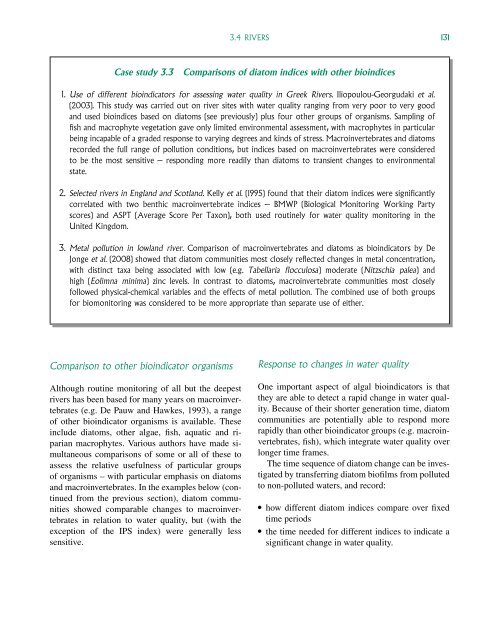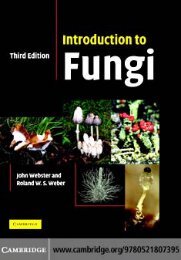Freshwater Algae: Identification and Use as Bioindicators
Freshwater Algae: Identification and Use as Bioindicators
Freshwater Algae: Identification and Use as Bioindicators
Create successful ePaper yourself
Turn your PDF publications into a flip-book with our unique Google optimized e-Paper software.
3.4 RIVERS 131C<strong>as</strong>e study 3.3Comparisons of diatom indices with other bioindices1. <strong>Use</strong> of different bioindicators for <strong>as</strong>sessing water quality in Greek Rivers. Iliopoulou-Georgudaki et al.(2003). This study w<strong>as</strong> carried out on river sites with water quality ranging from very poor to very good<strong>and</strong> used bioindices b<strong>as</strong>ed on diatoms (see previously) plus four other groups of organisms. Sampling offish <strong>and</strong> macrophyte vegetation gave only limited environmental <strong>as</strong>sessment, with macrophytes in particularbeing incapable of a graded response to varying degrees <strong>and</strong> kinds of stress. Macroinvertebrates <strong>and</strong> diatomsrecorded the full range of pollution conditions, but indices b<strong>as</strong>ed on macroinvertebrates were consideredto be the most sensitive – responding more readily than diatoms to transient changes to environmentalstate.2. Selected rivers in Engl<strong>and</strong> <strong>and</strong> Scotl<strong>and</strong>. Kelly et al. (1995) found that their diatom indices were significantlycorrelated with two benthic macroinvertebrate indices – BMWP (Biological Monitoring Working Partyscores) <strong>and</strong> ASPT (Average Score Per Taxon), both used routinely for water quality monitoring in theUnited Kingdom.3. Metal pollution in lowl<strong>and</strong> river. Comparison of macroinvertebrates <strong>and</strong> diatoms <strong>as</strong> bioindicators by DeJonge et al. (2008) showed that diatom communities most closely reflected changes in metal concentration,with distinct taxa being <strong>as</strong>sociated with low (e.g. Tabellaria flocculosa) moderate (Nitzschia palea) <strong>and</strong>high (Eolimna minima) zinc levels. In contr<strong>as</strong>t to diatoms, macroinvertebrate communities most closelyfollowed physical-chemical variables <strong>and</strong> the effects of metal pollution. The combined use of both groupsfor biomonitoring w<strong>as</strong> considered to be more appropriate than separate use of either.Comparison to other bioindicator organismsAlthough routine monitoring of all but the deepestrivers h<strong>as</strong> been b<strong>as</strong>ed for many years on macroinvertebrates(e.g. De Pauw <strong>and</strong> Hawkes, 1993), a rangeof other bioindicator organisms is available. Theseinclude diatoms, other algae, fish, aquatic <strong>and</strong> riparianmacrophytes. Various authors have made simultaneouscomparisons of some or all of these to<strong>as</strong>sess the relative usefulness of particular groupsof organisms – with particular emph<strong>as</strong>is on diatoms<strong>and</strong> macroinvertebrates. In the examples below (continuedfrom the previous section), diatom communitiesshowed comparable changes to macroinvertebratesin relation to water quality, but (with theexception of the IPS index) were generally lesssensitive.Response to changes in water qualityOne important <strong>as</strong>pect of algal bioindicators is thatthey are able to detect a rapid change in water quality.Because of their shorter generation time, diatomcommunities are potentially able to respond morerapidly than other bioindicator groups (e.g. macroinvertebrates,fish), which integrate water quality overlonger time frames.The time sequence of diatom change can be investigatedby transferring diatom biofilms from pollutedto non-polluted waters, <strong>and</strong> record: how different diatom indices compare over fixedtime periods the time needed for different indices to indicate <strong>as</strong>ignificant change in water quality.
















